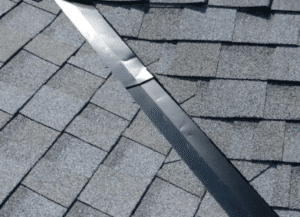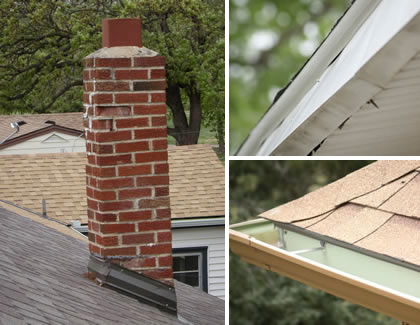Ultimate Guide To Roof Flashing
Table of ContentsWhat Is Roof Flashing? Why Is It Important?What Is Roof Flashing And Why Is It Important? (ProtectingAll About Roof FlashingWhy Is Roof Flashing An Important Roofing Component?
The water then streams from the roofing slopes down the valley and into the seamless gutters. One of the most typical methods water can enter homes is by method of chimney. However, chimney flashing assists to successfully stop water from getting in. The way this is done is by installing L-shaped metal pieces between shingles courses all together with a chimney.
Likewise referred to as the saddle roofing. Its purpose is to create a slope that keeps water from having the ability to collect behind a chimney. Then, a large piece of flashing covers the cricket roof and runs along with the shingle operate on top of it. Usually, it is mortared directly onto the chimney itself.
On the side of the chimney, counter flashing is also mortared onto either the stone or brick course and diminishes on top of the step flashing. Last but not least, chimney flashing is mortared on the front of a chimney. It is going to be mortared at the most affordable part of the roofing system slope.
This is where any water may run. And this is how chimney flashing works. As we have actually found out, flashing assists protect your roof and house from going into water. This likewise consists of piping and vents that sit atop your roof. On a lot of homes, you'll normally have at least a few vents or piping.
What Is Roof Flashing And Why Is It Important? (Protecting
For vents, the flashing is normally cone-shaped with a flange at the base. It is infiltrated the roofing system shingles as the roofing is initially applied. The method it works is that there is a main grow opening that how much to fix shingles on roof is made from metal. It also might be with a rubber compression that twists around PVC piping.
 All About Roof Flashing
All About Roof Flashing
The center will slip over the vent pipe. This is where it's installed below the roofing. In doing so, this makes water run out of and away from the pipe opening. For support with roofing system flashing for your home, please do not hesitate to call us. As a preferred roofing business in San Antonio, you can feel confident we will finish the job right for you.
Weatherproofing seam in between a stone chimney and a tile roof on a structure in Jersey, Channel Islands. The lead flashing is viewed as light gray sheets at the base of the chimney. Flashing describes slices of invulnerable material installed to avoid the passage of water into a structure from a joint or as part of a weather resistant barrier system.
Metal flashing materials include lead, aluminium, copper, stainless steel, zinc alloy, and other products. The origin of the term flash and flashing are commercial roofing companies in Tucson - DCRoofingArizona.com unpredictable, but might come from the Middle English verb flasshen, 'to sprinkle, splash', related to flask. Counter-flashing (or cover flashing, cap flashing) is a term utilized when there are two parallel pieces of flashing used together such as on a chimney, where the counter-flashing is constructed into the chimney and overlaps a replaceable piece of base flashing.
Edge Flashing For Your Roof
The up-hill side of a chimney may have a little gable-like assembly called a cricket with cricket flashing or on narrow chimneys with no cricket a back flashing or back pan flashing. Flashing may be let into a groove in a wall or chimney called a. Prior to the accessibility of sheet items for flashing home builders used innovative approaches to lessen water penetration such as angling roof shingles away from the joint, putting chimneys at the ridge, developing enter the sides of chimneys to shake off water and covering seams between roof materials with mortar flaunching.
thus making buildings more resilient and minimizing indoor mold issues. Additionally, flashing is essential to ensure integrity of the roof prior to a solar panel installation. In home builders books, by 1832 Loudons An Encyclopdia of Home, Farm, and Rental Property Architecture and Furnishings ... provides guideline on setting up lead flashing and 1875 Notes on Building Building and construction offers detailed instruction and is well highlighted with approaches still used today.
 Roof Flashing Tape, Roof Flashings
Roof Flashing Tape, Roof Flashings
https://www.google.com/maps/embed/v1/directions?key=AIzaSyAT8ig6vIZpArpz5aokN-7eevoH-Unfy0Y&origin=32.1433135,-110.9163409&destination=5956 S Avenida Caneca&mode=driving
Exposed flashing is usually of a sheet metal and hid flashing may be metal or a flexible, adhesive backed, product particularly around wall penetrations such as doors and window openings. In earlier days, birch bark was sometimes utilized as a flashing product. Many flashing materials today are metal, plastic, rubber, or fertilized paper.
Metal flashing must be provided with expansion joints on long terms to avoid deformation of the metal sheets due to expansion and contraction, and ought to not stain or be stained by nearby materials or react chemically with them. A crucial kind of prospective chemical response between metal flashing materials is galvanic rust.
Flashing (Weatherproofing) - What You Need To Know
Likewise, Aluminum and zinc flashing can not be utilized in contact with pressure treated wood due to rapid rust. Aluminum is also harmed by wet mortar and wet plaster. Salt spray in coastal locations may speed up rust; so stainless steel, copper, or covered aluminum are suggested flashing materials near seawater.
The various types have various application temperature level varieties, product adhesion compatibility, chemical compatibility, levels of unstable natural substances, and resistance to ultraviolet light direct exposure. No versatile flashing products are created for long-lasting exposure as are metal flashing materials. [] Adhesive backed materials are practical throughout installation, but such adhesives are not planned for long-lasting water-resistance. [] Copper is an excellent material for flashing because of its malleability, strength, solder-ability, workability, high resistance to the caustic impacts of mortars and hostile environments, and long service life (see: copper flashing).
https://www.youtube.com/embed/v7vbdIS1TaE
DC Roofing of Arizona
Tucson, AZ
(520) 979-9095
https://www.dcroofingarizona.com/
https://www.google.com/maps?cid=13615084232433183222
Since flashing is pricey to change if it stops working, copper's long life is a major expense benefit. Cold rolled (to 1/8-hard temper) copper is suggested for a lot of flashing applications. This product offers more resistance than soft copper to the tensions of expansion and contraction. Soft copper can be defined where extreme forming is required, such as in complicated roofing shapes.
